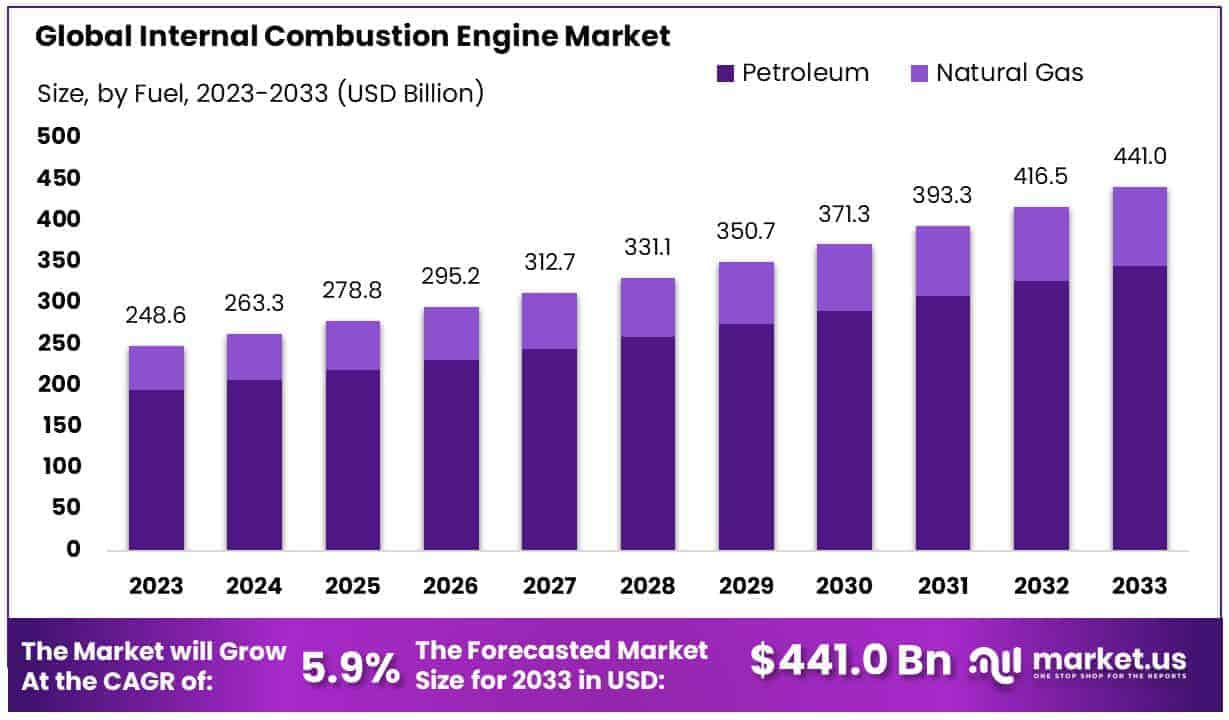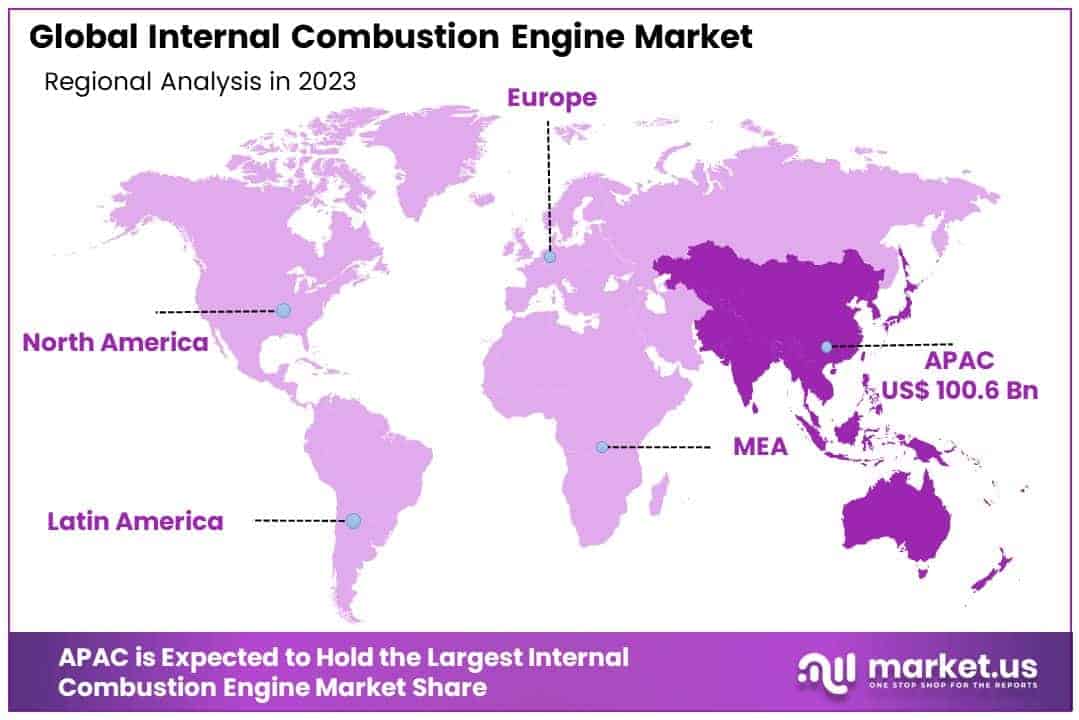Table of Contents
Introduction
The Global Internal Combustion Engine Market is projected to reach a valuation of approximately USD 441.0 billion by 2033, rising from USD 248.6 billion in 2023. This growth represents a compound annual growth rate (CAGR) of 5.90% during the forecast period spanning 2024 to 2033.
The internal combustion engine (ICE) is a critical technology that powers a vast array of machinery, including automobiles, industrial equipment, and marine vessels. It operates by igniting a fuel-air mixture within a combustion chamber, converting chemical energy into mechanical energy. The internal combustion engine market encompasses the production, distribution, and advancement of ICE technologies and components across automotive, aerospace, and industrial sectors. Key growth factors include the rising demand for vehicles in emerging economies, advancements in fuel efficiency, and the development of hybrid systems integrating ICE with electric powertrains.
Despite increasing global focus on electrification and emission regulations, demand remains robust in regions with limited EV adoption due to infrastructure constraints. Opportunities exist in innovation, such as biofuel-compatible engines and improved emission control technologies, catering to sustainability goals while meeting consumer demands. As industries transition, ICE remains indispensable in applications requiring high power and reliability.

Key Takeaways
- The global internal combustion engine market is projected to grow from USD 248.6 billion in 2023 to USD 441.0 billion by 2033, reflecting a CAGR of 5.90% from 2024 to 2033.
- Diesel and gasoline engines dominate with a 78.6% market share, driven by their high energy density and well-established infrastructure.
- The automotive sector represents 67.3% of the market, maintaining its position through hybrid technologies that combine performance, range, and lower emissions alongside conventional engines.
- Asia-Pacific (APAC) leads with a 40.5% market share, supported by robust automotive and industrial sectors. North America holds a 25.8% share, benefiting from strong automotive and aerospace industries.
Key Segments Analysis
Petroleum-based fuels, including diesel and gasoline, dominate the internal combustion engine market with a 78.6% share, valued for their energy density and widespread infrastructure. Diesel powers heavy-duty applications with efficiency and durability, while gasoline is popular for personal and light vehicles. Natural gas fuels, such as CNG and LNG, are gaining traction for lower emissions, driven by stricter regulations and expanding refueling networks. Emerging alternatives like biofuels and hydrogen blends are niche but expected to grow as technology and sustainability demands evolve.
The internal combustion engine market holds significant value across diverse sectors, with the automotive segment leading at 67.3%, driven by its critical role in powering most passenger and commercial vehicles. Despite the growing shift toward electric vehicles, hybrid models sustain demand by combining performance and efficiency. Marine and aircraft applications also underscore the engine’s reliability and power, essential for vessels and smaller aircraft, ensuring its continued relevance in sectors where durability and cost-effectiveness are paramount.
Report Scope
| Report Features | Description |
|---|---|
| Market Value (2023) | USD 248.6 Billion |
| Forecast Revenue (2033) | USD 441.0 Billion |
| CAGR (2024-2033) | 5.90% |
| Competitive Landscape | Ford AB, Nissan Motor Company, AG Volkswagen, Royce Holding Plc, Mahindra and Mahindra Ltd., Nissan SA, Tokyo Heavy Industries, MAN SE, Company General Motors, Automaker Ford, Dodge Chrysler, Bosch Robert GmbH, Corporation AGCO, Corporation Caterpillar |
Emerging Trends
- Integration with Hybrid Systems: ICEs are increasingly combined with electric powertrains to create hybrid vehicles, enhancing fuel efficiency and reducing emissions. This trend supports the automotive industry’s shift towards more sustainable transportation solutions.
- Advancements in Fuel Injection and Combustion Techniques: Innovations such as direct fuel injection and variable valve timing have improved engine efficiency and responsiveness, leading to better fuel consumption and power output.
- Development of Alternative Fuel Engines: Research into hydrogen-fueled internal combustion engines is progressing, offering potential for cleaner combustion and reduced greenhouse gas emissions.
- Enhanced Engine Downsizing: Manufacturers are producing smaller engines that deliver higher power outputs, improving fuel efficiency and reducing emissions without compromising performance.
- Focus on Sustainable Fuels: The exploration of synthetic and biofuels aims to make ICEs more environmentally friendly by lowering carbon footprints and utilizing renewable resources.
Top Use Cases
- Passenger Vehicles: ICEs power a vast majority of cars worldwide, providing reliable transportation for billions of people.
- Commercial Transportation: Trucks and buses equipped with ICEs are essential for goods delivery and public transit, supporting global economies.
- Agricultural Machinery: Tractors and harvesters rely on ICEs to perform vital farming operations, contributing to food production.
- Industrial Equipment: ICEs drive machinery such as generators and pumps, ensuring continuous operation in various industrial settings.
- Marine Vessels: Many boats and ships utilize ICEs for propulsion, enabling maritime trade and travel.
Major Challenges
- Environmental Regulations: Increasingly stringent emission standards require significant advancements in ICE technology to reduce pollutants.
- Competition from Electric Vehicles (EVs): The rise of EVs presents a challenge to ICEs, as consumers and policymakers seek cleaner alternatives.
- Fuel Efficiency Demands: There is a continuous need to improve fuel economy in ICEs to meet consumer expectations and regulatory requirements.
- Resource Dependency: ICEs rely heavily on fossil fuels, raising concerns about sustainability and energy security.
- Technological Limitations: Achieving further reductions in emissions and improvements in efficiency poses engineering challenges for ICE development.
Top Opportunities
- Hybrid Vehicle Integration: Combining ICEs with electric powertrains in hybrid vehicles can enhance fuel efficiency and reduce emissions, appealing to environmentally conscious consumers.
- Alternative Fuel Adoption: Developing ICEs compatible with biofuels or synthetic fuels can open new markets focused on sustainability.
- Emerging Markets Demand: In developing regions, the demand for affordable and reliable transportation can drive ICE sales.
- Technological Innovations: Advancements in materials and engineering can lead to more efficient and cleaner ICEs, maintaining their relevance in the automotive industry.
- Aftermarket Services: The extensive existing fleet of ICE vehicles creates opportunities in maintenance, repair, and retrofitting services.
Key Player Analysis
- Ford Motor Company is a leading American automaker with a substantial presence in the ICE market. The company has a long history of producing a wide range of vehicles powered by internal combustion engines, including popular models like the Ford F-Series trucks and the Mustang. Ford continues to invest in improving the efficiency and performance of its ICE vehicles while also expanding its portfolio to include electric and hybrid models.
- Volkswagen Group, headquartered in Germany, is one of the world’s largest automotive manufacturers. The company produces a diverse lineup of vehicles under various brands, many of which are equipped with internal combustion engines. Volkswagen has been focusing on enhancing the fuel efficiency and reducing the emissions of its ICE vehicles, even as it accelerates its transition towards electric mobility.
- Toyota Motor Corporation, based in Japan, is renowned for its innovation in the automotive sector. While Toyota is a pioneer in hybrid technology with models like the Prius, it also maintains a strong presence in the ICE market. The company continues to develop advanced internal combustion engines that offer improved performance and fuel efficiency, catering to a broad spectrum of consumer preferences.
- General Motors (GM) is a major American automotive manufacturer with a significant stake in the ICE market. GM produces a variety of vehicles across its brands, many powered by internal combustion engines. The company is committed to advancing ICE technology to meet stringent emission standards while simultaneously investing in electric vehicle development as part of its long-term strategy.
- Caterpillar Inc., an American corporation, is a leading manufacturer of construction and mining equipment, diesel and natural gas engines, and industrial gas turbines. The company’s internal combustion engines are integral to its machinery, providing reliable power for heavy-duty applications across various industries. Caterpillar continues to innovate in engine technology to enhance efficiency and reduce environmental impact.
Regional Analysis
Asia-Pacific Leads the Internal Combustion Engine Market with Largest Market Share of 40.5% in 2023
The Asia-Pacific region dominates the global internal combustion engine (ICE) market, accounting for a substantial 40.5% market share in 2023. Valued at an impressive USD 100.6 billion, this region showcases its significance as a key player in driving market growth. Factors contributing to Asia-Pacific’s leadership include its rapidly expanding industrial base, rising vehicular demand, and robust economic development in countries such as China, India, and Japan. These nations are spearheading advancements in automotive technology, bolstered by increasing government investments and initiatives to modernize infrastructure. The region’s dominance is further supported by the prevalence of manufacturing hubs and a growing consumer base, positioning Asia-Pacific as a pivotal force in the global ICE market landscape.

Recent Developments
- In 2024, Nissan, Honda, and Mitsubishi Motors entered into an agreement to explore potential collaboration. The memorandum of understanding (MOU) sets the stage for Mitsubishi Motors to evaluate its participation and contribution in a business integration initiative led by Nissan and Honda. The discussions involve the creation of a joint holding company to align their strategies and optimize synergies across operations.
- In 2024, Aramco completed the acquisition of a 10% stake in Horse Powertrain through its subsidiary, Aramco Asia Singapore Pte. Ltd. This move supports Aramco’s goal of advancing mobility solutions to lower emissions. The deal, based on a €7.4 billion valuation, was finalized after receiving regulatory approvals, with Renault Group and Geely maintaining equal stakes of 45% each.
- In 2023, Stellantis announced its investment of approximately €1.5 billion to secure a 20% stake in Leapmotor, marking a strategic partnership. The agreement also established Leapmotor International, a joint venture led by Stellantis, to manage export, sales, and manufacturing of Leapmotor products outside Greater China. This partnership highlights a pioneering collaboration between a global automaker and a Chinese electric vehicle manufacturer.
- In 2023, Cummins Inc. introduced its next-generation integrated powertrain at the American Trucking Associations’ Technology & Maintenance Council exhibition. This comprehensive system integrates engine, transmission, axles, and fuel delivery with advanced digital connectivity. The showcase aimed to provide North American fleet professionals with insights into cutting-edge technologies designed to optimize performance and efficiency.
Conclusion
The internal combustion engine (ICE) market is poised for steady growth in the coming decade, driven by ongoing technological advancements and sustained demand across various sectors. Despite the global shift towards electrification, ICEs continue to play a vital role, particularly in regions where electric vehicle infrastructure is still developing. Innovations aimed at enhancing fuel efficiency and reducing emissions are ensuring that ICEs remain competitive and relevant. Additionally, the integration of hybrid systems and the exploration of alternative fuels are opening new avenues for ICE applications. As industries and consumers seek reliable and efficient power solutions, the ICE market is expected to maintain its significance, adapting to evolving environmental standards and market dynamics.
Discuss Your Needs With Our Analyst
Please share your requirements with more details so our analyst can check if they can solve your problem(s)





